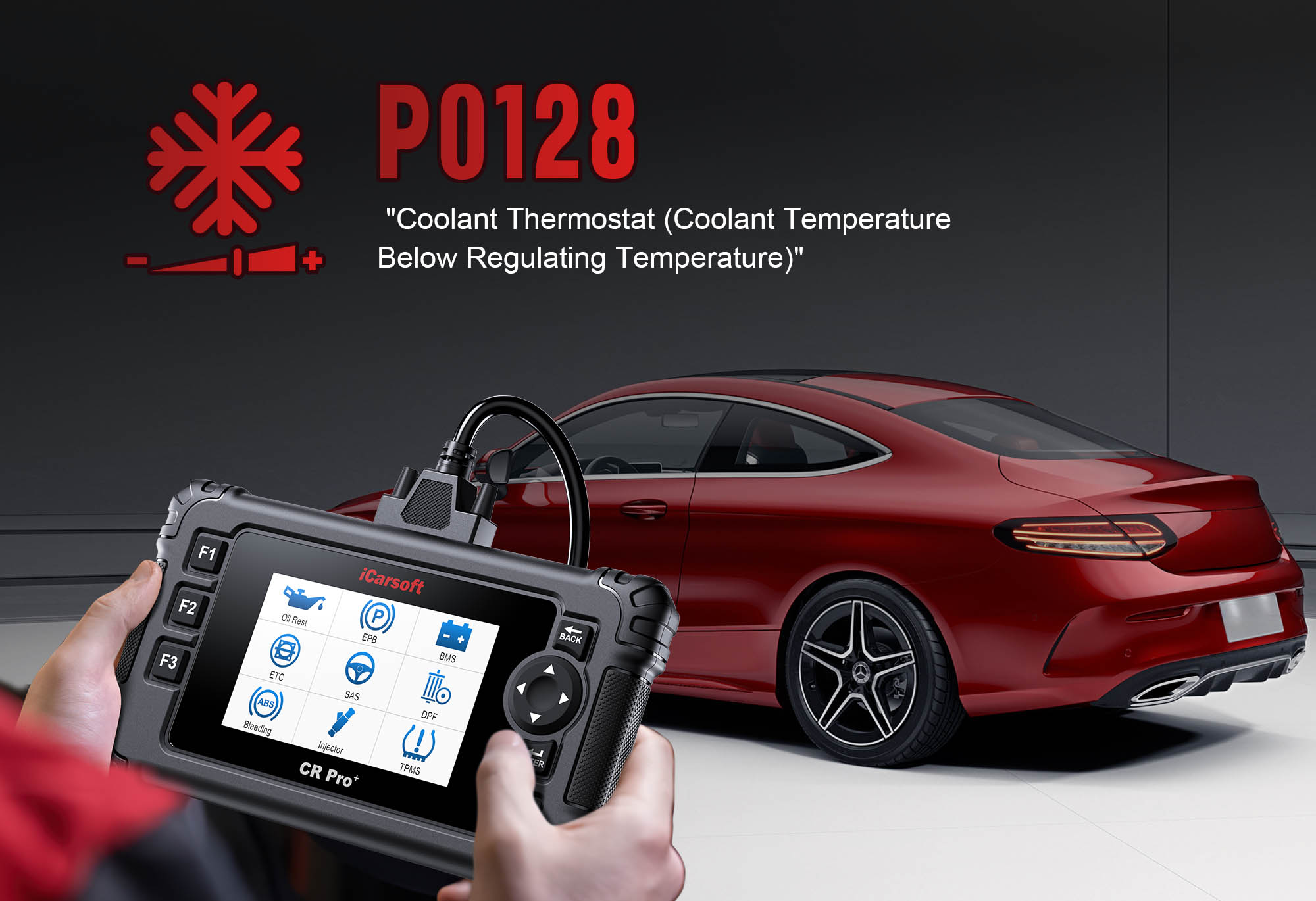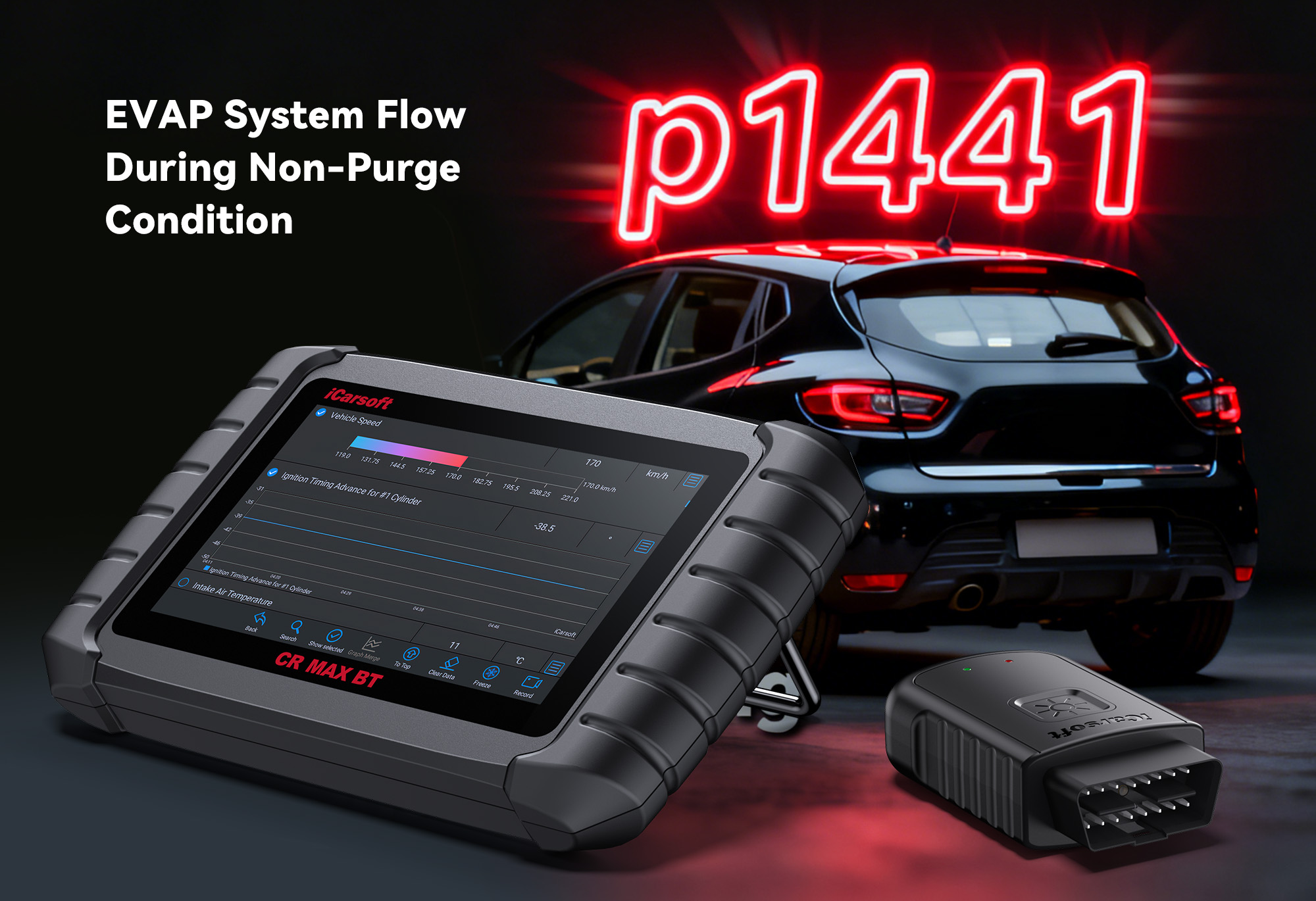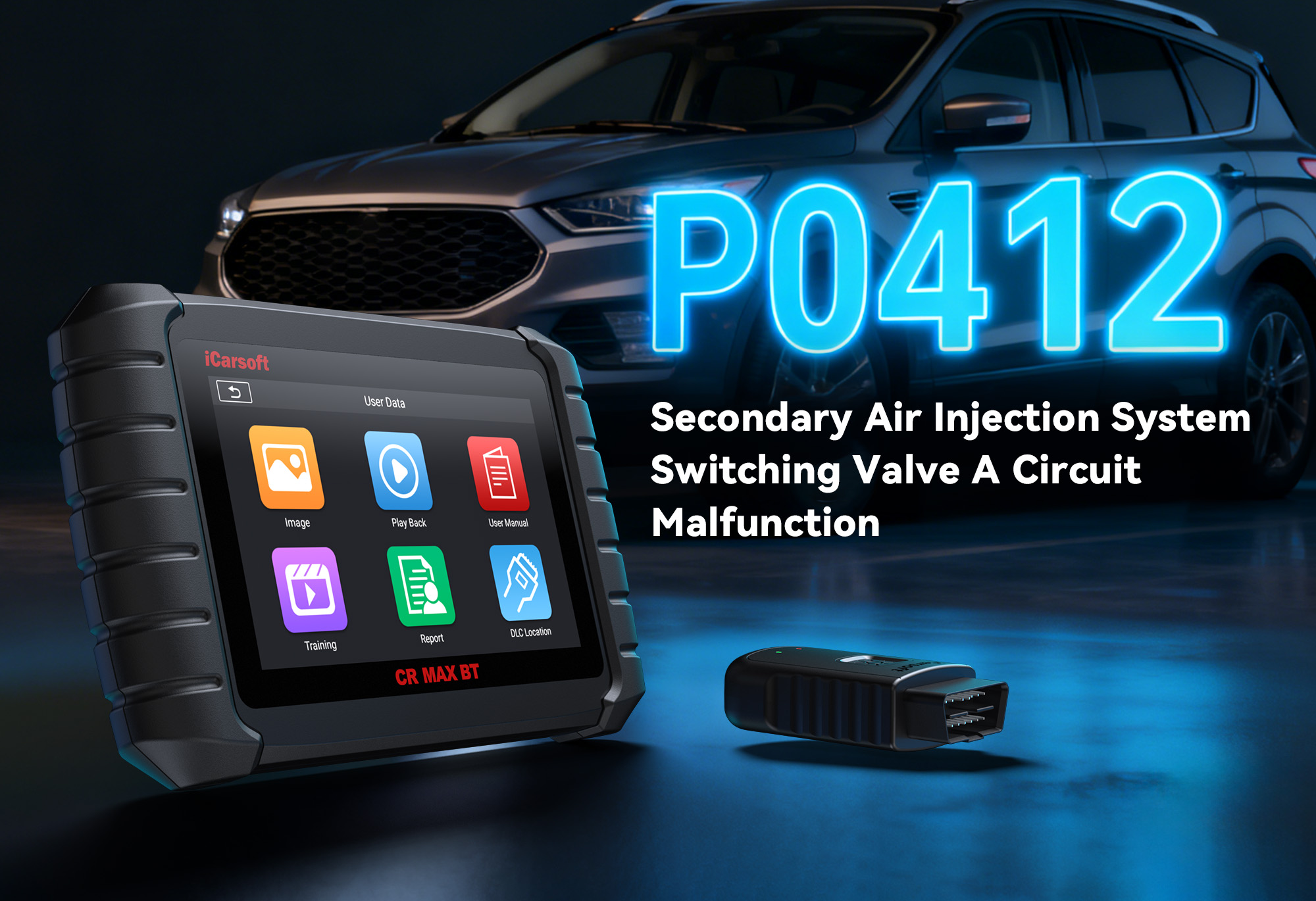Diagnose & Clear P0128 with iCarsoft CR Pro+: Fix Coolant Temperature Below Thermostat Regulation
If your check engine light turns on and a scan returns P0128, your vehicle’s engine cooling system is signaling a critical temperature issue. This generic OBD-II code stands for "Coolant Temperature Below Thermostat Regulation Range"—meaning the Engine Control Module (ECM) has detected that the engine coolant isn’t reaching its optimal operating temperature (typically 180–220°F / 82–104°C) within a specified time frame, usually 10–15 minutes of startup.
The engine’s thermostat acts as a "gatekeeper" for coolant flow: it stays closed when the engine is cold to help it warm up quickly, then opens to circulate coolant through the radiator once optimal temperature is reached. When P0128 occurs, the thermostat either stays stuck open (allowing coolant to flow too early) or is faulty (failing to restrict flow), preventing the engine from reaching efficient operating temperature. Left unaddressed, P0128 causes reduced fuel efficiency, increased engine wear (from cold operation), and failed emissions tests (due to incomplete fuel combustion).
Basic scanners might only label P0128 as a "coolant temperature fault" but can’t distinguish between a bad thermostat, low coolant, or a faulty temperature sensor. The iCarsoft CR Pro+—with its high-precision temperature monitoring, thermostat cycle tests, and cooling system diagnostics—solves this. Let’s walk through how to diagnose and resolve P0128.
Why It Matters
Ignoring P0128 may seem low-priority, but it harms your vehicle’s efficiency, longevity, and compliance:
-
Fuel Waste: Cold engines burn 10–20% more fuel—over a year, this adds up to $100–$300 in extra gas costs (depending on driving habits).
-
Engine Wear: Cold oil is thicker and can’t lubricate pistons, bearings, or camshafts effectively. Extended cold operation accelerates wear, shortening engine life by 10–15% over time.
-
Emissions Failure: Incomplete combustion from a cold engine spikes hydrocarbon (HC) and carbon monoxide (CO) levels—guaranteeing a failed state inspection, with re-test fees and potential fines.
-
Heater Inefficiency: A cold engine means no hot coolant for the heater—you’ll suffer from cold cabin air in winter, even after 15+ minutes of driving.
-
Cascading Cooling Issues: Low coolant (a common P0128 cause) can lead to overheating once the thermostat is fixed—causing radiator damage or a blown head gasket (a $1,500–$3,000 repair).
Understanding P0128: Causes & Key Symptoms
To tackle P0128 effectively, first map its impact on your vehicle’s performance and cooling system—this helps eliminate guesswork:
Key Symptoms of P0128
-
Persistent Check Engine Light: Illuminates after 2+ consecutive startup cycles where coolant stays below the thermostat’s regulated range.
-
Slow Engine Warm-Up: Heater takes 10+ minutes to blow hot air (normal is 5–7 minutes)—a clear sign coolant isn’t heating up fast enough.
-
Reduced Fuel Efficiency: Noticeably more frequent gas station visits—cold engines burn extra fuel to compensate for incomplete combustion.
-
Coolant Temperature Gauge Issue: Gauge stays below the "normal" range (e.g., below 180°F) even after 20+ minutes of highway driving.
-
Increased Engine Wear Signs: Rough idle during cold starts or unusual engine noise (from unlubricated parts) that fades as the engine finally warms.
-
Failed Emissions Tests: High HC/CO levels on test results—inspectors will flag P0128 as a critical fault.
Common Causes of P0128
|
Cause
|
Description
|
|
Stuck-Open Thermostat
|
Most frequent cause (60% of P0128 cases)—debris, rust, or corrosion prevents the thermostat from closing, allowing coolant to circulate nonstop and cool the engine prematurely.
|
|
Low Coolant Level
|
Insufficient coolant in the system reduces heat retention—even a small leak (e.g., from a worn hose gasket) can lower levels enough to trigger P0128.
|
|
Faulty ECT Sensor
|
Engine Coolant Temperature (ECT) sensor sends false low-temperature readings to the ECM—even if the engine is warm, the sensor tricks the ECM into thinking it’s cold.
|
|
Cooling Fan Malfunction
|
Fan runs continuously (even when the engine is cold) due to a faulty relay or control module—blows excess heat from the radiator, keeping coolant temperatures low.
|
|
Leaking Coolant System
|
Small leaks in hoses, radiator, water pump gasket, or heater core reduce coolant volume over time—low levels prevent the engine from retaining heat.
|
|
Incorrect Thermostat Rating
|
Installing a thermostat with a lower temperature rating (e.g., 160°F instead of the required 195°F) causes the engine to stay below the ECM’s target range.
|
Why iCarsoft CR Pro+ Excels at Diagnosing P0128
The CR Pro+ outperforms basic scanners with precision features tailored to cooling system diagnostics—critical for P0128, where 10°F temperature differences matter:
High-Resolution Temperature Monitoring
Tracks coolant temperature in 0.1°F increments (vs. 1–2°F on basic tools)—captures subtle fluctuations that reveal thermostat sticking or sensor errors.
Thermostat Cycle Analysis
Records when the thermostat opens/closes by detecting sudden coolant temp drops (open) or rises (close)—verifies if it’s functioning on schedule (e.g., opens at 195°F for Ford).
ECT Sensor Validation
Compares ECT sensor readings to intake air temperature (IAT) and engine oil temperature (EOT)—spots faulty sensors sending false low-temperature data.
Cooling Fan Control Tests
Bi-directionally activates the cooling fan to check for continuous operation—no need to disconnect wires; identifies stuck-on fans in 2 minutes.
Vehicle-Specific Cooling Data
Preloaded with thermostat ratings, coolant capacity, and sensor locations for 65+ makes (Ford Mustang, Chevy Malibu, Toyota Corolla)—ensures accurate diagnostics.
Warm-Up Time Tracking
Logs engine warm-up duration and compares it to manufacturer specs (e.g., 12 minutes for Honda Civic)—confirms if slow warm-up is outside normal ranges.
Step-by-Step: Diagnose P0128 with iCarsoft CR Pro+
-
1. Connect & Confirm the Code
1. Plug the CR Pro+ into your vehicle’s OBD-II port (under the dashboard) and power it on.
2. Select your vehicle via Auto VIN Scan (reads your VIN in 2 seconds) or manual entry (make/model/year/engine—critical for cooling system specificity).
3. Navigate to Engine > Fault Codes > Read Codes to confirm P0128. Tap Code Details for vehicle-specific insights (e.g., "Toyota: Coolant Temp < 176°F After 15 Minutes" or "Ford: Thermostat Regulation Failure").
-
2. Check for Related Cooling System Codes
P0128 rarely appears alone—scan for companion faults to narrow the root cause:
- P0117/P0118: ECT Sensor Low/High Voltage (faulty sensor, not thermostat)
- P0480/P0481: Cooling Fan Circuit Malfunction (fan running nonstop)
- P0597/P0598: Thermostat Heater Control Circuit Issues (electric thermostat failure)
- P0300: Random Misfire (from cold engine incomplete combustion)
Multiple codes = address systemic issues (e.g., low coolant + faulty sensor) instead of just one component.
-
3. Verify Coolant Level & Condition
Low coolant is an easy fix—always check this first to avoid unnecessary part replacement:
1. Ensure the engine is completely cool (wait 2+ hours after driving) to prevent scalding from pressurized coolant.
2. Locate the coolant reservoir (translucent plastic tank with "MIN"/"MAX" marks—usually near the radiator).
3. Check level: Add a 50/50 coolant-water mix (use the CR Pro+’s Coolant Type Lookup for vehicle-specific fluid, e.g., Toyota Super Long Life Coolant) if below "MIN."
4. Inspect coolant condition:
- Good: Bright green, orange, or pink (matches vehicle’s recommended type).
- Bad: Brown/black, cloudy, or has debris—needs flushing (use the CR Pro+’s Fluid Capacity Guide for proper volume).
-
4. Monitor Live Coolant Temperature & Thermostat Cycle
The CR Pro+’s real-time data reveals how the thermostat and ECT sensor perform during warm-up:
1. Start the cold engine (not driven for 4+ hours) and navigate to Engine > Live Data > Cooling System.
2. Select these parameters to monitor (add them to your "Favorites" for quick access):
- "Engine Coolant Temperature (ECT)"
- "Intake Air Temperature (IAT)"
- "Cooling Fan Status" (On/Off)
- "Thermostat State" (if supported—shows Open/Closed)
3. Let the engine idle and watch the data for 15–20 minutes—compare to normal vs. faulty behavior:
Normal Operation: ECT rises steadily to 180–220°F; thermostat opens (ECT drops 5–10°F suddenly); fan turns on only if ECT exceeds 220°F.
Stuck-Open Thermostat: ECT rises slowly (e.g., only reaches 160°F after 20 minutes) with no sudden drop.
Faulty ECT Sensor: ECT stays 20+°F lower than IAT (e.g., IAT = 70°F, ECT = 45°F) or doesn’t rise at all.
Stuck-On Fan: Fan runs immediately after startup, keeping ECT below 170°F.
-
5. Test the ECT Sensor for Accuracy
A faulty ECT sensor sends false low-temperature readings—validate it with the CR Pro+:
1. Turn off the engine and ensure it’s cool (ECT = IAT).
2. Navigate to Special Functions > Sensor Tests > ECT Sensor Validation.
3. The CR Pro+ displays the sensor’s resistance and compares it to manufacturer specs (e.g., 2000 ohms at 70°F, 200 ohms at 200°F).
4. Results:
- Resistance within range = sensor is good.
- Resistance outside range = replace the sensor (use the CR Pro+’s Part Lookup for OEM parts like Bosch 0280130038).
-
6. Check Cooling Fan Operation
A fan that runs nonstop cools the radiator prematurely—test it with the CR Pro+’s bi-directional control:
1. Ensure the engine is cold (ECT < 150°F) to avoid normal fan activation.
2. Navigate to Special Functions > Cooling System > Fan Control Test.
3. Run three tests:
- Fan Off: Fan should stop immediately (if it stays on = faulty fan relay or control module).
- Fan Low Speed: Fan should spin slowly (listen for reduced noise).
- Fan High Speed: Fan should spin rapidly (increased noise/airflow).
4. No response to any test = wiring issue or failed fan motor (replace as needed).
-
7. Perform a Coolant Pressure Test
Leaks reduce coolant volume—use the CR Pro+ with a compatible pressure test kit to detect them:
1. Connect the pressure test kit to the coolant reservoir (follow the kit’s instructions—use a kit rated for 10–15 psi).
2. Navigate to Special Functions > Cooling System > Pressure Test Monitoring.
3. Pressurize the system to your vehicle’s spec (10–15 psi—found in the CR Pro+’s Service Manual).
4. Monitor pressure for 10 minutes:
- Pressure holds steady = no leaks.
- Pressure drops = leak (inspect hoses, radiator, water pump gasket, and heater core for wet spots or coolant residue).
5. Repair leaks (replace hoses/gaskets) before proceeding to thermostat inspection.
-
8. Inspect the Thermostat (If All Else Checks Out)
If previous steps point to a thermostat issue, use the CR Pro+ to guide removal:
1. Navigate to Component Location > Thermostat—the scanner shows its position (usually near the upper radiator hose, connected to the engine block).
2. Follow the CR Pro+’s Thermostat Replacement Guide (includes safety steps and torque specs):
- Drain coolant to the "MIN" level (catch fluid in a pan to reuse if it’s new/clean).
- Remove the thermostat housing bolts (use a torque wrench later to avoid stripping).
- Extract the old thermostat—check for:
- Sticking (won’t close fully when cool).
- Debris/rust blocking the valve.
- Incorrect temperature rating (stamped on the thermostat—match to CR Pro+’s specs).
3. Clean the thermostat housing (remove old gasket residue) and install a new OEM thermostat (generic versions often fail early).
-
9. Repair & Clear P0128
Fix the root cause based on diagnostics—focus on the most likely issue first:
- Stuck-Open/Incorrect Thermostat: Replace with OEM (match temperature rating from CR Pro+).
- Faulty ECT Sensor: Swap with OEM part—torque to 8–10 ft-lbs (follow scanner’s specs).
- Stuck-On Fan: Replace the fan relay (location shown in Component Location) or control module.
- Leaks: Replace cracked hoses, worn gaskets, or a leaking radiator—refill coolant to "MAX."
- Old Coolant: Flush the system and refill with the correct 50/50 mix (use CR Pro+’s Fluid Capacity Guide).
Clear the code: Navigate to Engine > Fault Codes > Clear Codes to delete P0128 and related cooling system faults.
-
10. Verify the Repair
Confirm the engine reaches optimal temperature to avoid reoccurrence:
1. Warm-Up Test: Start the cold engine and monitor ECT via the CR Pro+—it should reach 180–220°F within 10–15 minutes.
2. Heater Check: Turn on the heater—hot air should blow within 5–7 minutes of startup.
3. Test Drive: Take a 30-minute drive (include highway and city driving) to ensure ECT stays in the normal range (no sudden drops/rise).
4. Re-Scan: Use the CR Pro+ to scan again—no return of P0128 + steady ECT = successful repair.
5. Emissions Readiness: Navigate to Readiness Monitors—confirm the ECT monitor is "Ready" for state inspections.
Preventing P0128 Recurrence
The CR Pro+ helps maintain a healthy cooling system long-term, avoiding future P0128 codes:
-
Coolant Maintenance: Use the CR Pro+’s Service Reminder to schedule coolant flushes every 30,000–50,000 miles (varies by vehicle—e.g., 100,000 miles for Toyota’s Super Long Life Coolant).
-
Thermostat Replacement: Replace the thermostat every 100,000 miles (before it sticks open)—set a reminder in the CR Pro+’s Maintenance Log.
-
Sensor Checks: Run the ECT Sensor Validation test annually to catch failing sensors early (before they trigger P0128).
-
Pressure Tests: Perform a coolant pressure test every 15,000 miles to detect small leaks before they reduce coolant volume.
-
Fan Inspections: Use the Fan Control Test seasonally (before summer/winter) to ensure the fan only runs when the engine is warm.
StepAction1Connect CR Pro+, confirm P0128, and review vehicle-specific code details2Scan for related cooling system codes (P0117, P0480, etc.)3Check coolant level/condition and refill if low4Monitor live ECT and thermostat cycle to spot stuck-open thermostats5Validate ECT sensor accuracy with sensor tests6Test cooling fan operation via bi-directional control7Perform coolant pressure test to detect leaks8Inspect/replace thermostat (if other tests rule out sensors/leaks)9Repair root cause and clear P012810Verify repair with warm-up test, test drive, and re-scan
Conclusion
P0128’s "coolant temperature below range" label hides its impact on fuel efficiency, engine life, and emissions compliance—but the iCarsoft CR Pro+ simplifies diagnosis with cooling system-specific tools. From tracking 0.1°F temperature changes to testing fan operation, the CR Pro+ eliminates guesswork, ensuring you fix the root cause (not just replace parts).
Whether you’re replacing a $30 thermostat, fixing a $15 hose leak, or swapping a $50 ECT sensor, the CR Pro+ guides every step—saving you time and money. By following this guide, you’ll restore optimal engine temperature, improve gas mileage, and extend your vehicle’s life—all with professional-grade accuracy, no dealer visit required.
FAQs About P0128 Code
Q: Can I drive my vehicle with P0128?
A: Yes, but only short-term (1–2 weeks). P0128 doesn’t cause immediate engine damage, but extended driving leads to fuel waste and accelerated wear. Avoid long highway trips—cold engines work harder at high speeds, worsening wear.
Q: Will a generic thermostat fix P0128?
A: Not recommended. Generic thermostats often have inconsistent temperature ratings (e.g., 185°F instead of the required 195°F) or poor build quality—they may stick open within months. Use the CR Pro+’s Part Lookup to find an OEM thermostat (e.g., Motorcraft for Ford, Denso for Toyota) that matches your vehicle’s specs.
Q: Why does P0128 return after replacing the thermostat?
A: Common reasons include: 1) Low coolant (forgot to refill after thermostat replacement), 2) Faulty ECT sensor (sending false low readings), 3) Incorrect thermostat orientation (installed upside down—check the CR Pro+’s Installation Guide), 4) Unrepaired leak (coolant level drops again after driving). Re-run the CR Pro+’s pressure test and ECT validation to find the issue.
Q: How much does it cost to fix P0128?
A: Costs vary by cause: Thermostat replacement = $30–$80 (DIY); ECT sensor = $20–$60 (DIY); Coolant hose/gasket repair = $15–$40; Radiator replacement = $200–$500 (professional); Cooling fan relay = $15–$30 (DIY). The CR Pro+ helps avoid overspending by identifying low-cost fixes first.





